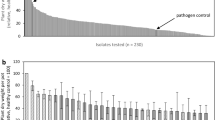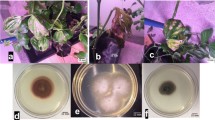Abstract
Seeds of five weed species were examined for the presence of seedborne bacteria. A total of 459 isolates were obtained from 1,740 seeds. The bacteria were identified and examined for distribution among seed viability classes, antifungal activity, and potential phytopathogenicity. Weed seeds varied for the prevalence of bacteria and in the types of bacteria associated with each plant species. Antifungal activity exhibited by 80% of the bacteria may limit seed deterioration by potential fungal seed pathogens. Some of the seedborne bacteria (15%) were potentially phytopathogenic. It is suggested that the complex nature of the weed seed-bacteria associations may be an obstacle to the development of biotic agents for manipulating weed seed activity in soil.
Similar content being viewed by others
References
Buchanan RE, Gibbons NE (1974) Bergey's manual of determinative bacteriology, 8th ed. Williams & Wilkins Co, Baltimore
Cubeta MA, Hartman GL, Sinclair JB (1985) Interaction betweenBacillus subtilis and fungi associated with soybean seeds. Plant Dis 69:506–509
Durbin RD (1982) Toxins and pathogenesis. In: Mount MS, Lacy GH (eds) Phytopathogenic prokaryotes. Vol. 1. Academic Press, New York, pp 423–441
Frederickson JK, Elliott LF (1985) Effects on winter wheat seedling growth by toxin-producing rhizobacteria. Plant Soil 83:399–409
Gasson MJ (1980) Indicator technique for antimetabolite toxin production by pathogenic species ofPseudomonas. Appl Env Microbiol 39:25–29
Gibson T, Gordon RE (1974) Genus I.Bacillus. In: Buchanan RE, Gibbons NE (eds) Bergey's manual of determinative bacteriology, 8th ed. Williams & Wilkins Co, Baltimore, pp 529–551
Graham DC, Hodgkiss W (1967) Identity of gram-negative, yellow pigmented, fermentative bacteria isolated from plants and animals. J Appl Bacteriol 30:175–189
Isenberg HD, Sampson-Scherer J (1977) Clinical laboratory evaluation of a system approach to the recognition of nonfermentative or oxidase-producing gram-negative, rod-shaped bacteria. J Clin Microbiol 5:336–340
Johnson LF, Curl EA (1972) Methods for research on the ecology of soilborne plant pathogens. Burgess Publishing Co, Minneapolis
Kremer RJ (1986) Microorganisms associated with velvetleaf (Abutilon theophrasti) seeds on the soil surface. Weed Sci 34:233–236
Kremer RJ, Hughes LB Jr, Aldrich RJ (1984) Examination of microorganisms and deterioration resistance mechanisms associated with velvetleaf seed. Agronomy J 76:745–749
Mayer AM, Poljakoff-Mayber A (1982) The germination of seeds. Pergamon Press, Oxford
Mundt JO, Hinkle NF (1976) Bacteria within ovules and seeds. Appl Env Microbiol 32:694–698
Neergaard P (1977) Seed pathology. Vol. 1. John Wiley & Sons, New York
Oberhofer TR, Rowen JW, Cunningham GS (1977) Characterization and identification of gram-negative, nonfermentative bacteria. J Clin Microbiol 5:208–220
Pettit RE, Taber RA, Foster BG (1968) Occurrence ofBacillus subtilis in peanut kernels. Phytopathology 58:254–255
Putnam AR, Duke WB (1978) Allelopathy in agro-ecosystems. Ann Rev Phytopathol 16:431–451
Simpson, ME, Marsh PB, Merola GV, Ferretti RJ, Filsinger EC (1973) Fungi that infect cottonseeds before harvest. Appl Microbiol 26:608–613
Stoller EW, Wax LM (1974) Dormancy changes and fate of some annual weed seeds in the soil. Weed Sci 22:151–155
Suslow TV, Schroth MN (1982) Role of deleterious rhizobacteria as minor pathogens in reducing crop growth. Phytopathology 72:111–115
Tenne FD, Foor SR, Sinclair JB (1977) Association ofBacillus subtilis with soybean seeds. Seed Sci Technol 5:763–769
Wallace RH, Lochhead AG (1951) Bacteria associated with seeds of various crop plants. Soil Sci 71:157–166
Winter DM (1960) The development of the seed ofAbutilon theophrasti. I. Seed coat. Am J Bot 47:157–162
Author information
Authors and Affiliations
Rights and permissions
About this article
Cite this article
Kremer, R.J. Identity and properties of bacteria inhabiting seeds of selected broadleaf weed species. Microb Ecol 14, 29–37 (1987). https://doi.org/10.1007/BF02011568
Issue Date:
DOI: https://doi.org/10.1007/BF02011568




